Themed collection Celebrating excellence in research: women of organic chemistry

A nano-catalytic approach for C–B bond formation reactions
Nanoparticle-catalysed borylation is one of the most convenient methods for the synthesis of organoboranes to overcome the confines of homogeneous catalysis such as recyclability and heavy metal contamination.
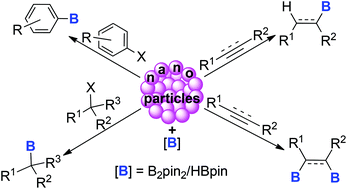
Org. Biomol. Chem., 2018,16, 857-873
https://doi.org/10.1039/C7OB02958F
The Piancatelli reaction and its variants: recent applications to high added-value chemicals and biomass valorization
The conversion of furfuryl alcohols by the Piancatelli reaction (and its C- and N-variants) provided highly functionalized cyclopentenones (intermolecular) and spirocycles (intramolecular).

Org. Biomol. Chem., 2018,16, 676-687
https://doi.org/10.1039/C7OB02962D
Advances in chemoselective intermolecular cross-benzoin-type condensation reactions
An exhaustive and critical overview of synthetically relevant methods for intermolecular cross-acyloin condensation reactions is reported.
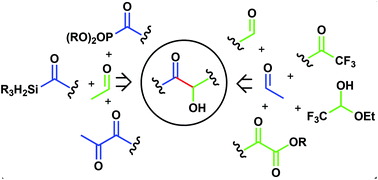
Org. Biomol. Chem., 2017,15, 6867-6887
https://doi.org/10.1039/C7OB01662J
Enantioselective magnesium-catalyzed transformations
This review updates the major progress in the field of enantioselective transformations promoted by chiral magnesium catalysts, covering the literature since 2007, illustrating the power of these green catalysts to promote many types of reactions.
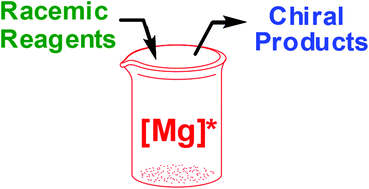
Org. Biomol. Chem., 2017,15, 4750-4782
https://doi.org/10.1039/C7OB00903H
Spatial organization of multi-enzyme biocatalytic cascades
Multi-enzyme cascades provide a wealth of valuable chemicals. Efficiency of reaction schemes can be improved by spatial organization of biocatalysts. This review will highlight various methods of spatial organization of biocatalysts: fusion, immobilization, scaffolding and encapsulation.

Org. Biomol. Chem., 2017,15, 4260-4271
https://doi.org/10.1039/C7OB00391A
Recent advances in organocatalytic enantioselective transfer hydrogenation
Robust, environmentally friendly reductants enable highly enantioselective reactions in the presence of chiral catalysts.
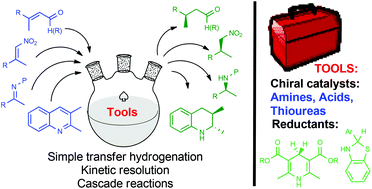
Org. Biomol. Chem., 2017,15, 2307-2340
https://doi.org/10.1039/C7OB00113D
Streamlined chemoenzymatic total synthesis of prioritized ganglioside cancer antigens
Highly efficient streamlined total synthesis of complex prioritized gangliosides was achieved chemoenzymatically by sequential one-pot multienzyme (OPME) reactions with facile C18 cartridge purification schemes followed by high-yield acylation.

Org. Biomol. Chem., 2018,16, 4076-4080
https://doi.org/10.1039/C8OB01087K
Enzyme-instructed self-assembly with photo-responses for the photo-regulation of cancer cells
Enzyme-instructed self-assembly was regulated by photo-irradiation to turn on the fluorescence as well as to induce a disassembly process.

Org. Biomol. Chem., 2017,15, 6892-6895
https://doi.org/10.1039/C7OB01548H
Pd-Catalyzed double N-arylation of primary amines to synthesize phenoxazines and phenothiazines
Pd-Catalyzed tandem N-arylation of primary amines with aryl halides to synthesize phenoxazine and phenothiazine derivatives.

Org. Biomol. Chem., 2017,15, 6306-6309
https://doi.org/10.1039/C7OB01540B
Identification of new DNA i-motif binding ligands through a fluorescent intercalator displacement assay
This work describes a new way to screen for i-motif binding compounds and several new families of ligands with potential for use in experiments into the structure and function of i-motif DNA.
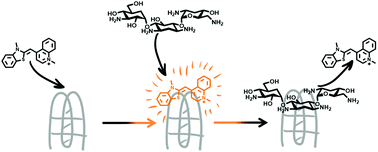
Org. Biomol. Chem., 2017,15, 5669-5673
https://doi.org/10.1039/C7OB00710H
Imidazolium-labeled glycosides as probes to harness glycosyltransferase activity in human breast milk
Imidazolium-labeled (ITag-) glycosides have been used to harness the glycosyltransferase activity directly from human breast milk (HBM). The technology is exemplified in the synthesis of biologically relevant oligosaccharide analogs, ITag-LacNAc, ITag-Lewisx and ITag-Lewisa, in a matter of days from (HBM) without isolating the enzymes.
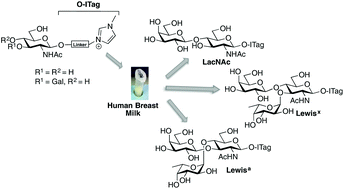
Org. Biomol. Chem., 2017,15, 3575-3579
https://doi.org/10.1039/C7OB00550D
Direct palladium-mediated on-resin disulfide formation from Allocam protected peptides
We present a mild, convenient method for direct conversion of Allocam protected peptides to disulfide-containing protected peptides on solid support.

Org. Biomol. Chem., 2017,15, 2914-2918
https://doi.org/10.1039/C7OB00536A
Why do A·T and G·C self-sort? Hückel aromaticity as a driving force for electronic complementarity in base pairing
Computations reveal that the potential for aromaticity gain and loss in nucleobases play key roles in modulating base pairing strengths.
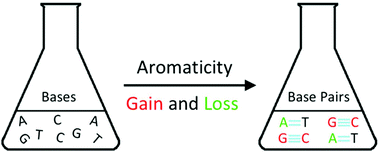
Org. Biomol. Chem., 2019,17, 1881-1885
https://doi.org/10.1039/C8OB01669K
Campestarenes: new building blocks with 5-fold symmetry
New campestarene derivatives bear functional groups designed to facilitate the formation of supramolecular assemblies of these 5-fold symmetric building blocks.
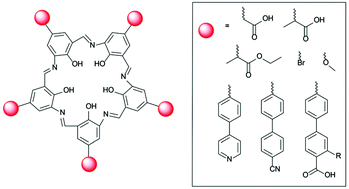
Org. Biomol. Chem., 2018,16, 6460-6469
https://doi.org/10.1039/C8OB00957K
Unraveling the 4n − 1 rule for DNA i-motif stability: base pairs vs. loop lengths
The 4n − 1 repeat pattern for poly-2′-deoxycytidine i-motifs results from ideal loop lengths and core base pairs.
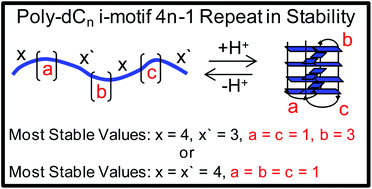
Org. Biomol. Chem., 2018,16, 4537-4546
https://doi.org/10.1039/C8OB01198B
Time-lapse monitoring of TLR2 ligand internalization with newly developed fluorescent probes
Bacterial lipopeptide fluorescent probes were developed as TLR2 ligands, and their time-lapse monitoring of cellular internalization was performed.
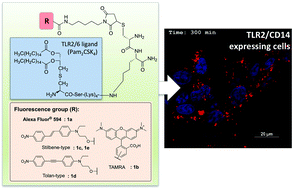
Org. Biomol. Chem., 2018,16, 3824-3830
https://doi.org/10.1039/C7OB03205F
Synthesis of plasmodione metabolites and 13C-enriched plasmodione as chemical tools for drug metabolism investigation
A 10-step synthesis of the antimalarial lead, 13C18-enriched plasmodione, and of seven putative metabolites is described.

Org. Biomol. Chem., 2018,16, 2647-2665
https://doi.org/10.1039/C8OB00227D
A visible-light photocatalytic thiolation of aryl, heteroaryl and vinyl iodides
A method for the light-driven synthesis of aryl and vinyl alkyl thioethers from a range of C(sp2)–I bonds is reported.

Org. Biomol. Chem., 2018,16, 1543-1551
https://doi.org/10.1039/C8OB00238J
Fluorescent and colorimetric molecular recognition probe for hydrogen bond acceptors
We report on the development of a dual molecular recognition probe for hydrogen bond acceptors.

Org. Biomol. Chem., 2017,15, 9603-9610
https://doi.org/10.1039/C7OB02092A
Computational insights into active site shaping for substrate specificity and reaction regioselectivity in the EXTL2 retaining glycosyltransferase
QM(DFT)/MM calculations and molecular dynamics simulations on wild-type retaining α1,4-N-acetylhexosaminyltransferase (EXTL2) and Arg293Ala, Asp246Ala, Arg293Ala/Asp246Ala and Asp246Glu mutants are used to understand the role of these two residues.
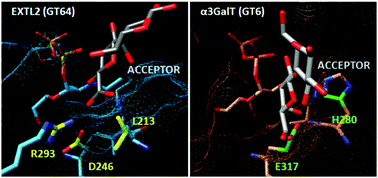
Org. Biomol. Chem., 2017,15, 9095-9107
https://doi.org/10.1039/C7OB01937H
Pseudouridine modifications influence binding of aminoglycosides to helix 69 of bacterial ribosomes
Pseudouridine modifications in helix 69 of bacterial ribosomes impact aminoglycoside interactions by altering the RNA conformational states and accessibility to chemical probes.
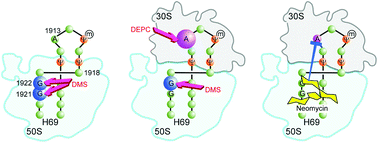
Org. Biomol. Chem., 2017,15, 8535-8543
https://doi.org/10.1039/C7OB02147J
The templation effect as a driving force for the self-assembly of hydrogen-bonded peptidic capsules in competitive media
Complexation of a hydrophobic guest induces the self-assembly of peptide based cavitands to form hydrogen-bonded ordered capsules in polar solvents.
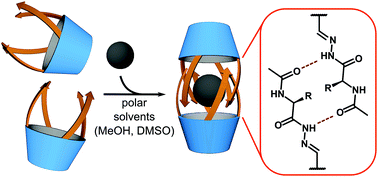
Org. Biomol. Chem., 2017,15, 8513-8517
https://doi.org/10.1039/C7OB01925D
Synthesis of functionalized indolizines via gold(I)-catalyzed intramolecular hydroarylation/aromatization of pyrrole-ynes
Gold-catalyzed intramolecular hydroarylation/aromatization of pyrrole-ynes to functionalized indolizines through the construction of the pyridine ring of indolizines has been developed.

Org. Biomol. Chem., 2017,15, 8119-8133
https://doi.org/10.1039/C7OB02102J
Deuteration and tautomeric reactivity of the 1-methyl functionality of free-base dipyrrins
Regioselective reactivity of the 1-methyl group of free-base dipyrrins is explored, including discussion of tautomerism to provide exocyclic alkenyl reactivity.
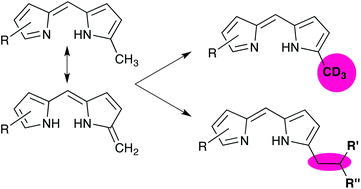
Org. Biomol. Chem., 2017,15, 7925-7935
https://doi.org/10.1039/C7OB01278K
Optimization of a synthetic receptor for dimethyllysine using a biphenyl-2,6-dicarboxylic acid scaffold: insights into selective recognition of hydrophilic guests in water
Introduction of an endo-carboxylate in a building block for dynamic combinatorial chemistry resulted in amplification of a new host with a Kd of 200 nM for dimethyllysine, a biologically important post-translational modification.
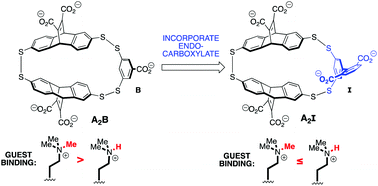
Org. Biomol. Chem., 2017,15, 7789-7795
https://doi.org/10.1039/C7OB01921A
Laser flash photolysis of nanocrystalline α-azido-p-methoxy-acetophenone
Irradiation of nanocrystals of azide 1 results in a solid-to-solid photoreaction that forms imine 2 in high chemical yield.
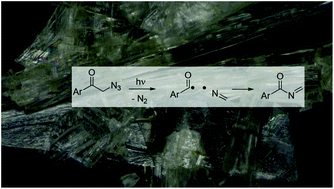
Org. Biomol. Chem., 2017,15, 7380-7386
https://doi.org/10.1039/C7OB01731F
Pd-Catalyzed regioselective C–H halogenation of quinazolinones and benzoxazinones
A Pd-catalyzed ortho-selective halogenation of benzoxazinone and quinazolinone scaffolds has been described employing N-halosuccinimide via C–H bond activation.

Org. Biomol. Chem., 2017,15, 6264-6268
https://doi.org/10.1039/C7OB01534H
Strategy towards the enantioselective synthesis of schiglautone A
The enantioselective synthesis of a functionalized intermediate comprising 6 of the 7 stereocenters of schiglautone A is reported and features a lithiation–borylation enzymatic resolution sequence.

Org. Biomol. Chem., 2017,15, 6242-6256
https://doi.org/10.1039/C7OB00766C
Multi-responsive polypeptide hydrogels derived from N-carboxyanhydride terpolymerizations for delivery of nonsteroidal anti-inflammatory drugs
Multi-responsive polypeptide-based hydrogels exhibited thermo-, mechano-, and enzyme-responsive properties, enabling performance as a delivery system for encapsulation and release of naproxen.

Org. Biomol. Chem., 2017,15, 5145-5154
https://doi.org/10.1039/C7OB00931C
Copper-catalyzed oxidative decarboxylative coupling of α-keto acids and sulfoximines
The formation of N-aroylsulfoximines via a copper-catalyzed oxidative decarboxylative coupling of α-keto acids with NH-sulfoximines is reported.

Org. Biomol. Chem., 2017,15, 4320-4327
https://doi.org/10.1039/C7OB00776K
Exploring the reversal of enantioselectivity on a zinc-dependent alcohol dehydrogenase
Alcohol Dehydrogenase (ADH) enzymes catalyse the reversible reduction of prochiral ketones to the corresponding alcohols.
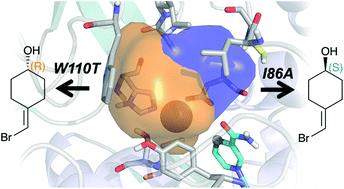
Org. Biomol. Chem., 2017,15, 4122-4129
https://doi.org/10.1039/C7OB00482F
Synthesis of oxazolidinones: rhodium-catalyzed C–H amination of N-mesyloxycarbamates
N-Mesyloxycarbamates undergo intramolecular C–H amination reactions to afford oxazolidinones in good to excellent yields in the presence of rhodium(II) carboxylate catalysts.
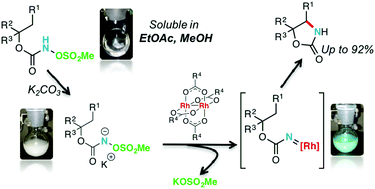
Org. Biomol. Chem., 2017,15, 4144-4158
https://doi.org/10.1039/C7OB00378A
Synthesis of N-alkyl-3-sulfonylindoles and N-alkyl-3-sulfanylindoles by cascade annulation of 2-alkynyl-N,N-dialkylanilines
Divergent synthesis of N-alkyl-3-sulfonylindoles and N-alkyl-3-sulfanylindoles from 2-alkynyl-N,N-dialkylanilines and sulfonyl hydrazides has been described.

Org. Biomol. Chem., 2017,15, 3662-3669
https://doi.org/10.1039/C7OB00366H
Towards the biodegradation pathway of fosfomycin
A degradation intermediate, a pro-metabolite and an enzyme inhibitor have been synthesised to study the biodegradation of fosfomycin in R. huakuii PMY1.
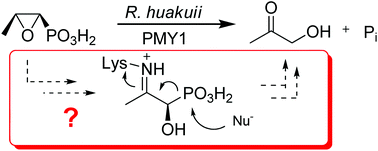
Org. Biomol. Chem., 2017,15, 3276-3285
https://doi.org/10.1039/C7OB00546F
Twisting the ethano-Tröger's base: the bisamide
A simple benzylic oxidation of ethano-Tröger's base derivatives affords novel twisted amides for structure and reactivity studies.

Org. Biomol. Chem., 2017,15, 628-633
https://doi.org/10.1039/C6OB02359B
About this collection
To coincide with Vote 100, the centenary of women obtaining the right to vote in the UK, the RSC highlighted 100 top quality articles from women in chemistry, selected by journal editorial teams and editorial board members. However, this was only a small selection of our excellent authors, and there were many more nominations. Here, we highlight some of the high quality research produced by women at the forefront of organic chemistry and chemical biology.